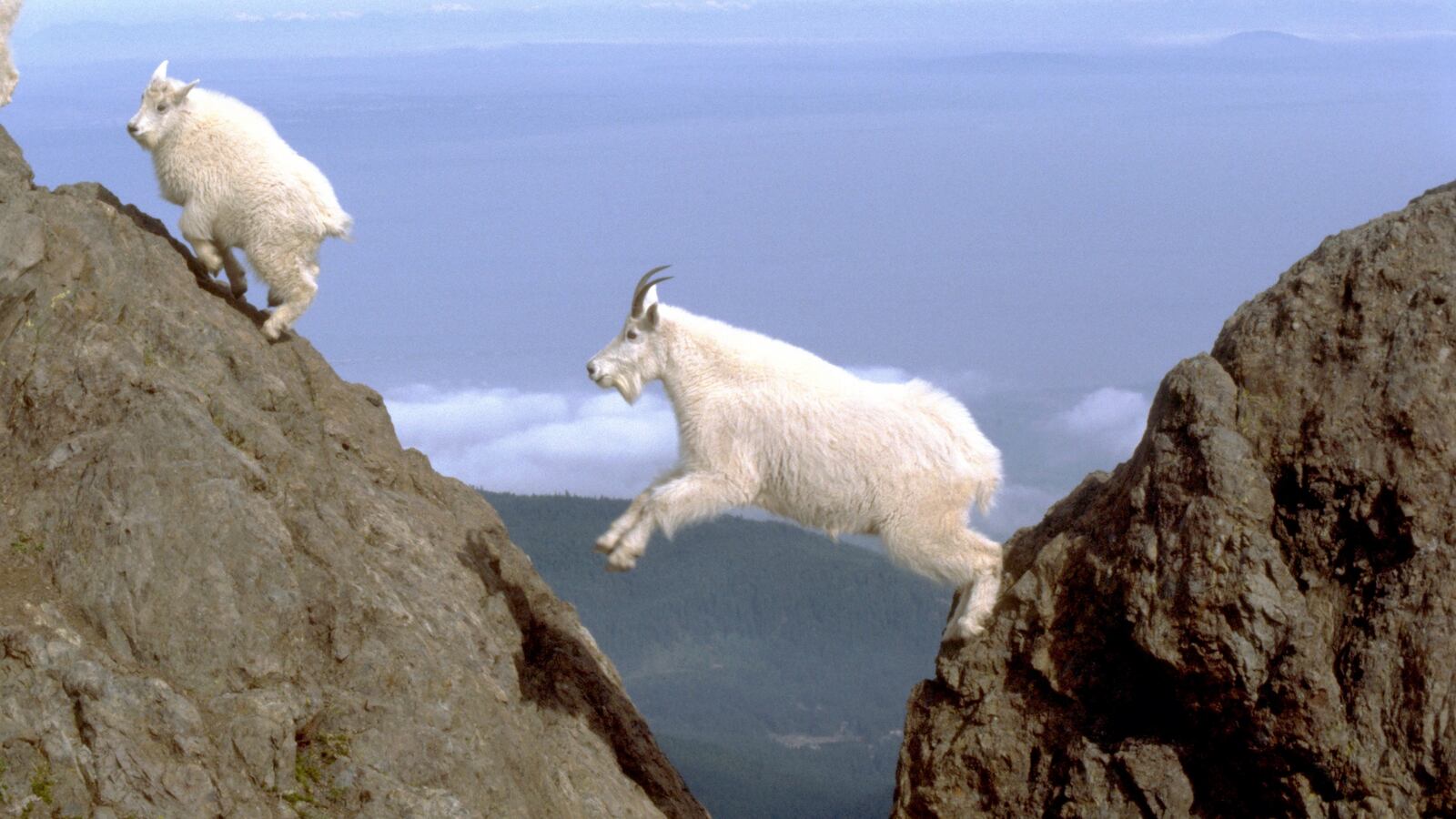It’s open season in Grand Teton National Park.
You can’t keep the meat and you can’t keep trophies, but despite prevailing conservation management practices, from Sept. 14 to Nov. 13 volunteers have been selected to head into the dramatic mountain range to scramble up jagged rocks, teeter around on exposed cliffs, and sneak around bear country in camouflage, all in the name of helping to reduce an invasive mountain goat population that is a threat to the native bighorn sheep.
It’s technically referred to as a “cull,” because of the rules surrounding it: there’s no fair chase, park rangers are offering help as to where the goats might be located, and the volunteers have been directed to “kill as many as is suitable in the situation.”
The goal is eradication—not sport.
“This is every hunter's dream,” says Kristi Combs, the executive director of the Wyoming Wildlife Advocates, “You’re letting them loose inside a national park to kill as many goats as possible.”
In theory, that’d be fine. While campfires and tents come to mind in a national park, hunting is frequently used as a method for removing invasive species or controlling population, and in this case the mountain goats are a direct threat to the native bighorn sheep. The problem isn’t hunting itself, but instead, how the park arrived at using hunting as its primary conservation method.
No—it wasn’t science that won the day for determining the best conservation method, but instead intrastate political pressure. The state of Wyoming threw its weight around and imposed their philosophy of conservation onto federally sanctioned land. This sets an interesting, and complicated, precedent for the state’s involvement in the management of federal lands moving forward.
In December 2018, the National Park Service (NPS) published their Environmental Assessment where they determined the best way to remove the invasive mountain goats from the park. The NPS selected a method that originally relied mostly on helicopter sharpshooting for the aerial removal of the mountain goats.
Even though a helicopter flying around a national park gunning down goats might sound like the making of a grim action movie, it’s actually not unheard of as an invasive species management tactic. It’s effective, especially given the rocky terrain and high altitude of the Tetons, which makes it difficult to access on foot alone.
In that original statement, the idea of volunteer on-the-ground culling was dismissed as “ineffective” and “duplicative,” when contrasted with helicopter gunning. However, after several comments, “including the Wyoming Game and Fish Department’s (WGFD) recommendation that the preferred alternative be modified to include the use of skilled volunteers,” the NPS reconsidered and in 2019, allowed it in tandem with aerial removal.
In February of 2020, the park began its removal plan. Within 24 hours of the helicopter taking off, the aerial sharpshooters had made substantial progress, eradicating 38 goats in one day which is about one-third of the total number of goats in the park.
However, despite this success, the choppers were soon grounded indefinitely and the aerial removal plan was effectively halted.
In a strongly worded letter to the acting superintendent of Grand Teton National Park, Wyoming Governor Mark Gordon expressed his “profound disappointment that the NPS chose to act unilaterally aerially executing mountain goats over the State of Wyoming’s objections.” He wrote, threateningly, “I will remember your blatant disregard for the advice of Wyoming’s Game and Fish Department.”
Governor Gordon explained his rationale to The Daily Beast: “We felt because of COVID, that meat was going to go wanting. People could make use of the meat. Hunting for your family is a tradition we all cherish in Wyoming.”
While the governor mentioned meat waste as a chief concern for grounding the helicopters, Combs argued, “it shouldn’t matter. The park had their hearing and made their decision and then the state of Wyoming bullied them to stop. It’s a national park, not a state forest. They don’t have that kind of jurisdiction.”
Bart Melton, the Wildlife Program director of the National Parks Conservation Association told the Daily Beast that, “It’d be fine if Wyoming and the NPS worked together on a solution. But that’s not what happened. That’s what happened leading up to this, but Wyoming didn’t like the result. So instead, the governor forced this new plan into action.”
While Combs and Melton view this as a blatant unilateral action, the very kind the governor was opposed to in the first place, Grand Teton National Park’s Public Affairs Officer Denise Germann doesn’t see it that way. She views the park’s new course of action as “using all the tools in the park’s toolbelt.”
“We listed three methods: aerial removal, transplantation, and volunteer culling. We’re using all three,” she says. “We’re focusing on volunteer culling at the moment.”
But Combs disagrees. “Even if the original plan was to use all three methods, it was made clear to the public that it would rely heavily on aerial sharpshooting. But that's not what's happening. They’ve amended their plan to focus primarily on volunteer cullers without reopening a public hearing to discuss the best course of action.”
This case raises an issue over whether states should be involved in the conservation methods, decisions, and philosophies of the national parks that exist within their borders. The National Environmental Policy Act mentions state consultation; however, it requires federal agencies to measure the environmental impacts of proposed actions that would affect federal lands and determine solutions to conserve and manage these lands appropriately, with public approval.
Melton went on to explain how the NPS should absolutely communicate with relevant states on cross-jurisdictional issues such as decisions on management of invasive wildlife. The problem is that Wyoming stepped in and used political influence to throw the public process out the window and elevated the state of Wyoming’s perspective above the available science and voices of the American public, without opportunity for comment.
Moreover, it doesn’t seem like volunteer culling has been very effective.
Over the week of Sept. 14-20, Germann told The Daily Beast, “3 goats were removed by volunteer cullers.” Of the three, “only meat from one goat was able to be retrieved.”
Not only is that a very low number of ungulates, that’s still a lot of meat going wanting.
Melton says, “If we assume that’s the average for the weeks remaining, this could take years and the potential for disease transfer to bighorn sheep won’t be going away anytime soon. Compare that with removing almost a third of the population aerially in one day. We shouldn’t even be talking about this anymore.”
State politics has muddied a process, and a non-native species removal that should’ve been straightforward.
“Congress did not set aside Teton National Park so it could be managed in conjunction with the state of Wyoming,” Melton says. “We have a major invasive species issue at parks across the country that are impacting those lands and their broader ecosystems.” He wondered how we are going to effectively deal with those problems if we aren’t focused on efficiency, first and foremost.
“This isn’t a question of whether hunting is right or wrong. It’s about what’s right for a national park,” he said.

